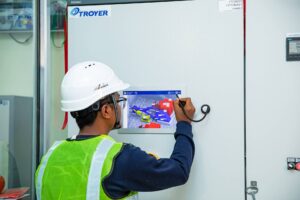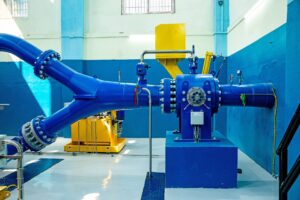Alpine hydropower technology from South Tyrol excels in mastering challenges at the foot of the Himalayas
Early this year a brand new hydropower plant went online on the Chepe river in the central Nepalese district of Gorkha. The project is part of a comprehensive expansion programme that is set to transform the country at the foot of the Himalayas into one of the foremost hydropower nations worldwide. In implementing the new Super Chepe plant, the operators relied on the competence and qualities of a European-based hydropower specialist from the Alpine region. Prominent South Tyrolean water-to-wire provider Troyer was contracted to supply the entire electromechanical and control engineering equipment for the facility. Equipped with two 2-nozzle Pelton turbines representing an installed overall bottleneck capacity of 9.05 MW, the new power plant is designed to supply around 55 GWh of clean energy to the local grid.

© Troyer AG
Nepal’s hydropower potential has always been considered to be somewhat legendary. However, a lot of water had to flow down the country’s 6,000 or so rivers before initial steps could be taken to harness this vast potential. One reason for this was the low domestic per-capita energy consumption – the lowest, in fact, in all of Southeast Asia, at a mere 325 kWh, and there was another reason, albeit a rather more political one: for decades, hydropower construction had been within the purview of the state, which generally lacked the necessary funds to fulfil its responsibility – while the private sector was barred from stepping into the breach. Only with democratisation in the 1990s and the accompanying liberalisation of the electricity market did this gradually change. Even after this turning point, however, the prevalent blackouts that had afflicted the country for many years kept putting a damper on further hydropower expansion plans. As of the end of 2023, Nepal’s 142 hydropower plants represented an installed capacity of 2,603 MW, according to the latest SINTEF Report. This is rather underwhelming, considering that a brand new study published by the “Asian Development Bank” found the country’s realistic hydropower potential to be around 72,000 MW. Note that this estimate is taking only the country’s ten largest rivers and their major tributaries into account.

© Troyer AG
Kick-off to construction in 2021
Still, unlike years ago when high-large-scale hydropower plans rarely used to come to fruition, the Nepalese market has recently been seized by a new, altogether different kind of dynamic. As of the beginning of this year, 244 new hydropower projects were under construction. These alone represent a total energy supply of around 8,760 MW, with further ambitious plans already in the works: By 2035, Nepal plans to expand its hydropower capacity to around 28,000 MW.
One of the latest and most advanced facilities among the new hydropower projects, Super Chepe in the Gorkha district, went online early this year. Situated in the central Himalayas and sharing its border with China, the Gorkha district is home to four major rivers, the Chepe being one of them. The plan for a new power plant to utilise the river’s hydroelectric potential was developed by Ridge Line Energy Pvt. Ltd, one of Nepal’s leading providers in the fast-growing renewable energy sector. In 2018, the project’s operator had signed a Power Purchase Agreement with NEA (Nepal Electricity Authority). Not long after that, they were granted official planning permission by the Nepalese Department of Electricity Development. With the administrative hurdles cleared, construction could finally commence in June 2021.
Construction hampered by difficult conditions
The Super Chepe hydropower plant is a high-pressure run-of-river facility with a catchment area of 49.23 square kilometres. Complementing a lateral intake and two long sand trap channels, the water chamber was built at 1,848 m above sea level. From there, the DN900 overground penstock runs along a 4.4 km route to the new power house, 1,290 m above sea level. This way, the facility can make full use of a natural terraced gradient of almost 560 m. Using a 33 kV line, the power generated is fed to the substation at Tanahu, around 30 km away. Implementing the construction project posed quite a few challenges. The heavy rainfall during and especially after the monsoon season ultimately caused delays in the construction process. Added to this was the risk of landslides, which was already known in advance due to the geographical location. A landslide occurred during the commissioning work in 2023, damaging part of the penstock. The work could only be completed once the section had been replaced.

© Troyer AG
Water-to-Wire qualities in high demand
Ensuring a high level of quality throughout was a top priority for the plant’s operators at Ridge Line Energy Pvt. Ltd, which is run by a young and highly competent management team. Hydropower plant Super Chepe was awarded the status of a true flagship project. For this reason, any compromise in terms of quality or implementation was to be avoided, especially where the electromechanical equipment was concerned. For the management team at Ridge Line Energy and their technical consultants, this was reason enough to contract one of the foremost hydropower specialists in the Alpine region: Troyer, which is headquartered in South Tyrol, Italy. Signed in May 2021 in Nepal, the contract was for an all-in-one technical package, consisting of the delivery, installation and commissioning of the electromechanical equipment, including the generators as well as the control engineering and secondary equipment. It was a great opportunity for the South Tyrolean provider to prove its competence as a water-to-wire specialist far away from home, in South Asia.
Bringing together efficiency and durability
The core elements of the facility are two identical 2-nozzle Pelton turbines by Troyer, each of them crafted for a design flow rate of each 1.100 l/s at a net head of 540 m. Together, the two machines have a bottleneck capacity of 9,05 MW. Each of the turbines drives a DC coupled synchronous generator with a nominal rotational speed of 1,000 rpm. For the Nepalese operators, the deciding factors that convinced them to rely on high-quality technology by the South Tyrolean hydropower all-rounders were twofold: the efficiency of latest-generation impeller technology, and the superior manufacturing quality, durability and sustained operational reliability. The experience gained from thousands of power plant projects completed in the Alpine region – and far beyond – throughout the company’s history provided the solid basis for Troyer’s first project in Nepal.

© Troyer AG
Challenging transport and installation
“A project in a new country always brings new challenges. You don’t know in advance all the circumstances that await you there – whether it’s the culture, the people or simply customs requirements,” says Troyer AG’s project manager, Florian Winkler. Especially the transport of the machines held some considerable challenges. After all, the delivery all the way to the Nepalese border had to be organised from the firm’s head offices in the South Tyrolean town of Sterzing. The assembly also played a decisive role. Although several assistant fitters were assigned by the client, in order to be able to guarantee the usual Troyer quality, a fitter from the South Tyrolean company was required to be on site. “The assemblyl was certainly a challenge for our team. Accommodation was set up right next to the construction site, where the team lived and was always catered for. Work was quite strenuous, with several weeks scheduled to complete the installation,” as Florian Winkler explains. In the end, however, the effort was to pay off. On January 6, 2024, the power station was finally taken online and has been running like clockwork ever since.
India needs Nepal’s hydropower
In a normal year, the Super Chepe hydropower facility will deliver around 54,75 GWh of clean energy to the local grid. This makes it not only a key project for the operators at Ridge Line Energy Pvt. Ltd, it also marks a major step in meeting the Nepalese government’s overall expansion target. And this target is also closely associated with Nepal’s big southern neighbor, India. India’s own energy programme calls for 50 % of the country’s required energy to be supplied by renewable sources. Nepalese hydropower also plays a crucial role in meeting this target. As reported by the Reuters news agency, the governments in New Delhi and Kathmandu have signed an agreement to buy electricity produced in Nepal for more than 10,000 MW of hydropower over the next ten years. No doubt this deal will add further momentum to Nepal’s dynamic hydropower expansion efforts. As a result, the Super Chepe facility stands as a symbol of advanced, quality-driven hydropower utilisation in the country at the foot of the Himalayas. For South Tyrolean provider Troyer AG as equipment supplier for the plant, this market premiere has definitely paid off as well. Super Chepe is an attractive reference project that has already earned the Alpine-based hydropower all-rounders nine follow-up contracts in Nepal.